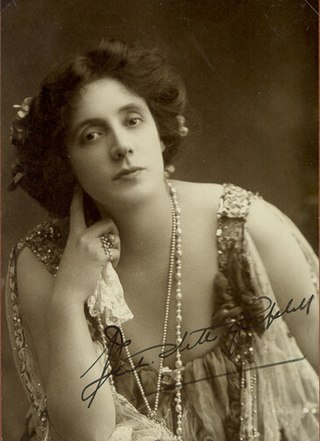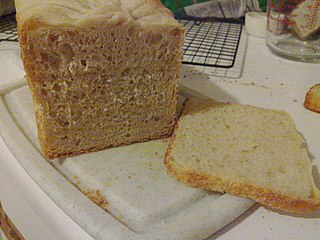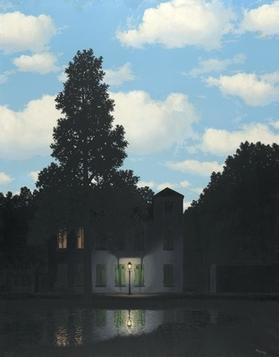
Harry Austen La Montagne was a French-American horse owner, artist, sculptor, war veteran and sportsman. [1]

Harry Austen La Montagne was a French-American horse owner, artist, sculptor, war veteran and sportsman. [1]
Born to wine merchant Auguste La Montagne and Anne Davis La Montagne, daughter of Thomas E. Davis, Harry estimated he spent half of his life in France and the other half in the United States. [2]
Educated at the Académie Julian in Paris, Harry was the brother-in-law of Nobel Peace Prize recipient Nicholas Murray Butler. [3]

La Montagne married Emma Morgan, daughter of Thomas Morgan, in New London, Connecticut on March 2, 1871. She was reported as ill in 1898 and was listed on a joint passport application in 1899, but there is no trace of her when Harry La Montagne held the post of General Manager at the Golden Link Mining Company in Arizona in 1905. [4] [5] [6] [7]
In 1906, he was presumably a widower when he married Beatrice Kinney on April 30, 1906 at St. Patrick's Cathedral presided by Archbishop Farley. [8] “Bea” was the daughter of Francis Sherwood Kinney and Mary Brady. He was one of the founders of Kinney Brothers Tobacco Company, which they merged with American Tobacco Company, the subject of one of the earliest antitrust cases before the Supreme Court requiring the break-up of the company in 1911. His brother, the second co-founder of the company was Abbot Kinney who is most famous for developing the beachfront neighborhood of Venice in Los Angeles.

In 1911 Harry moved his stables to France during the movement to abolish racetrack gambling. [10] Shortly after the outbreak of World War I, Harry returned to the United States after his horses were confiscated by the French government for war service. [11] After the couple’s return to the United States, they spent time between Narragansett, New York and Aiken, South Carolina, where the La Montagnes hunted with Frederick Henry Prince and John Harvey Wright Junior, present and past Masters of the Pau Hounds. [12]
In 1917, La Montagne enlisted at the age of 47 and served in France attaining the rank of major and was the recipient of the French Légion of Honor on May 16, 1919. [13]
Between 1920 and 1939, the La Montagnes spent each winter at Pau, France renting the Villa Regina, where Harry La Montagne first commissioned Sir Alfred Munnings to paint Beatrice La Montagne's portrait in 1921 and then his own. [14] The La Montagnes were active in Pau’s Anglo-American colony, being members of the English Club, the Golf Club and the Société de Encouragement. They were also subscribers to the Pau Hunt. [12]
Harry La Montagne was the owner of Conniver, namesake of the Conniver Stakes. Beatrice La Montagne died at their apartment in the Plaza Hotel on December 22, 1948. [15] Harry died at the apartment on June 15, 1959.
Harry La Montagne was an amateur artist. The majority of his works were presented to family and friends as gifts. Harry painted with watercolors, gouache, ink and oil. He sculpted in terra cotta and bronze. The majority of his works are still in the possession of those families, several of which were members of the English Club at Pau. A recent donation of over 200 of his works was recently made by the family of Odette Dewavrin. This collection consists of two sketchbook albums and 82 postcard Pau Hunt Meet notices with watercolor, gouache and ink designs Harry La Montagne offered to Miss Dewavrin.

Henry Valentine Miller was an American novelist, short story writer and essayist. He broke with existing literary forms and developed a new type of semi-autobiographical novel that blended character study, social criticism, philosophical reflection, stream of consciousness, explicit language, sex, surrealist free association, and mysticism. His most characteristic works of this kind are Tropic of Cancer, Black Spring, Tropic of Capricorn, and the trilogy The Rosy Crucifixion, which are based on his experiences in New York City and Paris. He also wrote travel memoirs and literary criticism, and painted watercolors.

Gouache, body color, or opaque watercolor is a water-medium paint consisting of natural pigment, water, a binding agent, and sometimes additional inert material. Gouache is designed to be opaque. Gouache has a long history, having been used for at least twelve centuries. It is used most consistently by commercial artists for posters, illustrations, comics, and other design work.

Francis Picabia was a French avant-garde painter, writer, filmmaker, magazine publisher, poet, and typographist closely associated with Dada.

Beatrice Rose Stella Tanner, better known by her stage name Mrs Patrick Campbell or Mrs Pat, was an English stage actress, best known for appearing in plays by Shakespeare, Shaw and Barrie. She also toured the United States and appeared briefly in films.

Honoré-Victorin Daumier was a French painter, sculptor, and printmaker, whose many works offer commentary on the social and political life in France, from the Revolution of 1830 to the fall of the second Napoleonic Empire in 1870. He earned a living producing caricatures and cartoons in newspapers and periodicals such as La Caricature and Le Charivari, for which he became well known in his lifetime and is still remembered today. He was a republican democrat, who satirized and lampooned the monarchy, politicians, the judiciary, lawyers, the bourgeoisie, as well as his countrymen and human nature in general.

La Belle Ferronnière is a portrait of a lady, usually attributed to Leonardo da Vinci, in the Louvre. It is also known as Portrait of an Unknown Woman. The painting's title, applied as early as the seventeenth century, identifying the sitter as the wife or daughter of an ironmonger, was said to be discreetly alluding to a reputed mistress of Francis I of France, married to a certain Le Ferron. Later she was tentatively identified as Lucretia Crivelli, a married lady-in-waiting to Duchess Beatrice of Milan, who became another of the Duke's mistresses.

The Rose Period comprises the works produced by Spanish painter Pablo Picasso between 1904 and 1906. It began when Picasso settled in Montmartre at the Bateau-Lavoir among bohemian poets and writers. Following his Blue Period – which depicted themes of poverty, loneliness, and despair in somber, blue tones – Picasso's Rose Period represents more pleasant themes of clowns, harlequins and carnival performers, depicted in cheerful vivid hues of red, orange, pink and earth tones.

Jeffrey P. DeMunn is an American stage, film and television actor known for playing Captain Esteridge in The Hitcher (1986), Sheriff Herb Geller in The Blob (1988), Andrei Chikatilo in Citizen X (1995), Harry Terwilliger in The Green Mile (1999), Ernie Cole in The Majestic (2001), Dan Miller in The Mist (2007), Dale Horvath in The Walking Dead (2010–2012), and Charles Rhoades Sr. in Billions (2016–2023).
Manolo Millares was a Spanish painter.

The Pullman loaf, sometimes called the "sandwich loaf" or "pan bread", is a rectangular loaf of white bread baked in a long, narrow, lidded pan. The French term for this style of loaf is pain de mie, or, less commonly, pain anglais.

Frederick Henry Prince was an American stockbroker, investment banker and financier.

Luca Penni (c.1500/1504–1556) was an Italian painter of the 16th century, best known for his work in France as part of the First School of Fontainebleau. He was nicknamed Le Romain.

The French writer and folklore collector Henri Pourrat was born in 1887 in Ambert, a town in the mountainous Auvergne region of central France. He died near Ambert in 1959.

Ray Kinney was a Hawaiian-born singer, musician, composer, orchestra leader, and performer on radio, stage and screen.

Lawrence Waterbury II was an American champion polo player and society figure.

The Empire of Light is the title of a succession of paintings by René Magritte. They depict the paradoxical image of a nocturnal landscape beneath a sunlit sky. He explored the theme in 27 paintings from the 1940s to the 1960s. The paintings were not planned as a formal series. They have never all been exhibited together and are rarely exhibited in smaller groups. The original French title, L'Empire des Lumieres is sometimes translated as singular, The Empire of Light,and sometimes as plural The Empire of Lights. Other translations include The Dominion of Light: making the distinction: "an empire exists in relation to a ruler, a dominion does not necessarily require this.”
Thomas Edward Davis or Davies was a prolific real estate developer who built residential properties in New York between 1830 and 1860.
John Lonergan was an American artist, educator and writer. He worked for the Federal Arts Project. Lonergan worked in various mediums including gouache, drawing in charcoal and ink, lithography and screen printing. His art often depicted the sea, and the men who worked it.

The English Club of Pau is a private social club in Pau, France. It owns and conserves a decorative arts and book collection listed as a French monument historique (ISMH). The English Club’s mission includes an annual open house during the Journées de Patrimoine and for reserved non-profit group tours, conferences, member publications and club member activities, all concentrated on the education and promotion of Pau’s former Anglo-American colony. It is housed at the Villa Lawrance by the City of Pau.

Philip H. Morgan was an attorney, jurist, and diplomat from Louisiana who remained loyal to the Union during the American Civil War. A Republican, among the offices in which he served were Associate Justice of the Louisiana Supreme Court (1873-1877), Judge of the International Tribunal in Alexandria, Egypt (1878-1880), and Minister to Mexico (1880-1885).
{{cite book}}: CS1 maint: multiple names: authors list (link)